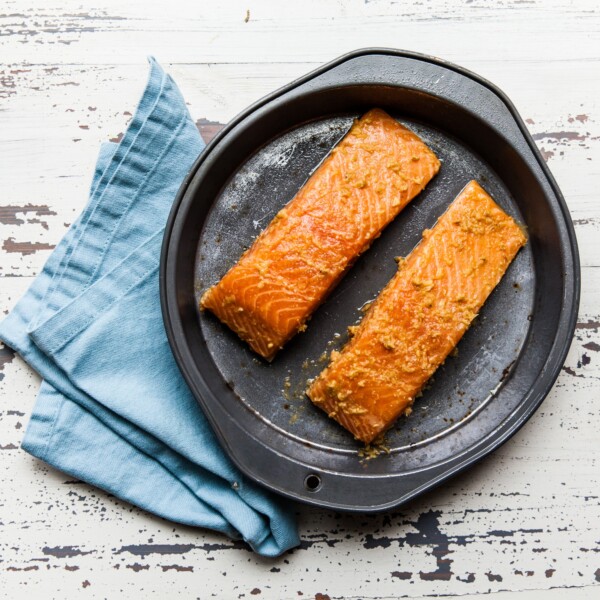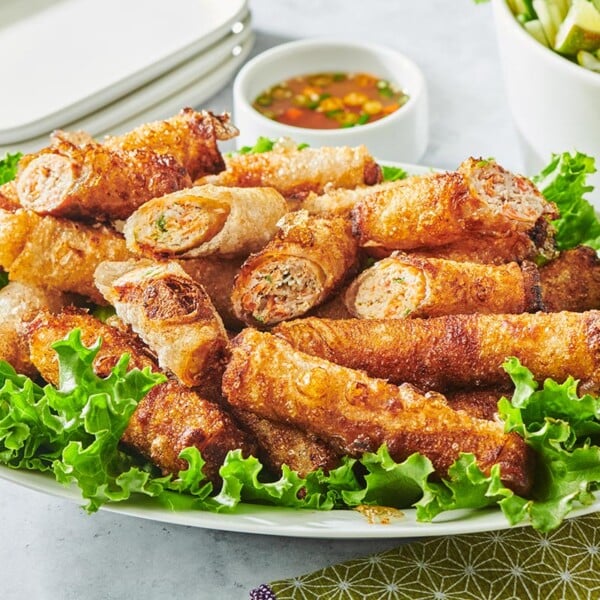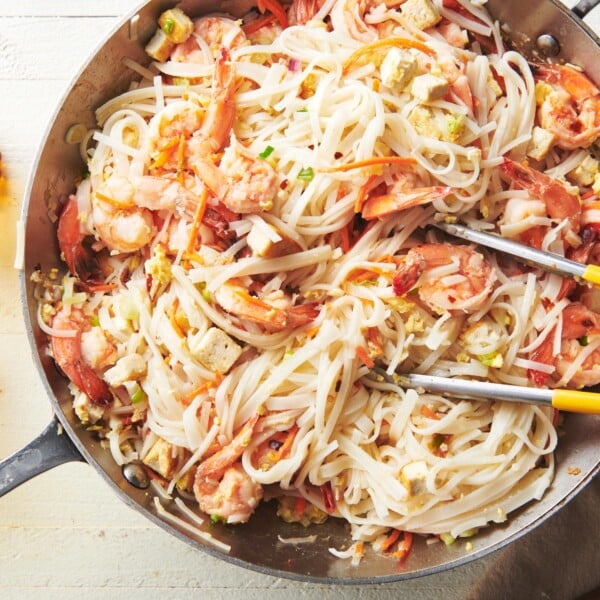Vietnamese Green Mango Salad with Shrimp (Goi Xoai)
on Mar 16, 2024, Updated Jan 17, 2025
This post may contain affiliate links. Please read our disclosure policy.
Colorful, bright, and crunchy, this salad is a refreshing meal or a beautiful part of a Southeast Asian spread.
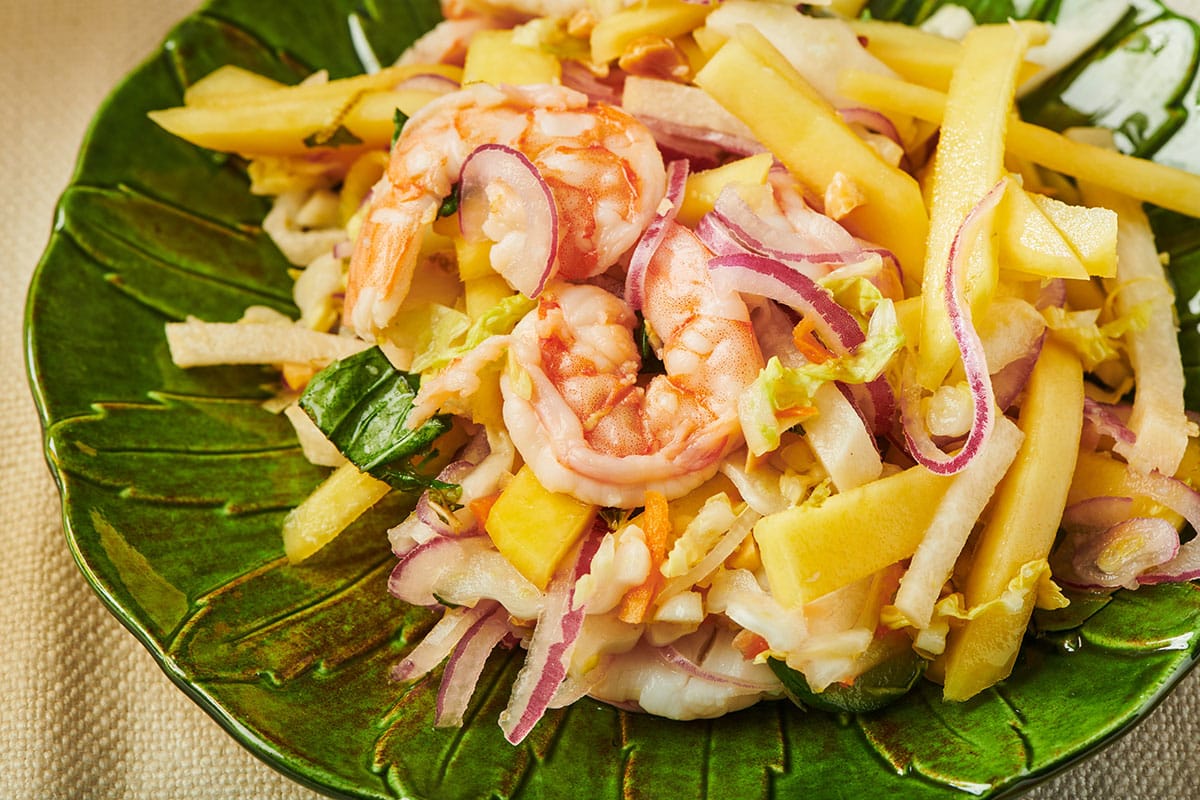
The slightly sour flavor and crunchy texture of green mango makes this Vietnamese Mango Salad with Shrimp (or Goi Xoai) recipe sing. The tangle of colorful ingredients, the blend of textures, and the energy of the dressing make it hard to stop eating. It’s no wonder salads of this type are so popular throughout Vietnam and Southeast Asia.
According to Binh Duong, in his book Simple Art of Vietnamese Cooking, co-authored with Marcia Keisel, the farther south you go in Vietnam, the more tropical it becomes, and the more salads, or goi, you can find. Vietnamese salads, on the whole, are made with ingredients chosen for their compatible flavors, texture, and colors for a pretty dynamic eating experience. The sauces or dressing are intended to enliven and brighten the ingredients.
By signing up, you agree to our Privacy Policy.
In many parts of Vietnam green papaya is used in the salad instead of mango. The salad might then be called Goi Du Du.
This recipe was inspired by Andrea Nguyen’s mango salad recipe in her book, Vietnamese Food Any Day. It would be delicious served with Thai chicken thighs, Southeast Asian green beans with lemongrass, Vietnamese cucumber salad, and many other Asian-inspired dishes. This salad is perfect as a light entree or it can be part of a spread of Southeast Asian dishes.
What's In This Post?
- Choosing Mangos for Salad
- Cutting Mangos for Mango Salad
- Ingredients for Vietnamese Mango Salad with Shrimp
- Variations and Substitutions
- How to Make Vietnamese Green Mango Salad
- Leftovers and Storage
- FAQs
- What to Serve With Vietnamese Green Mango and Shrimp Salad
- More Asian-Inspired Salads
- Vietnamese Green Mango Salad with Shrimp (Goi Xoai) Recipe
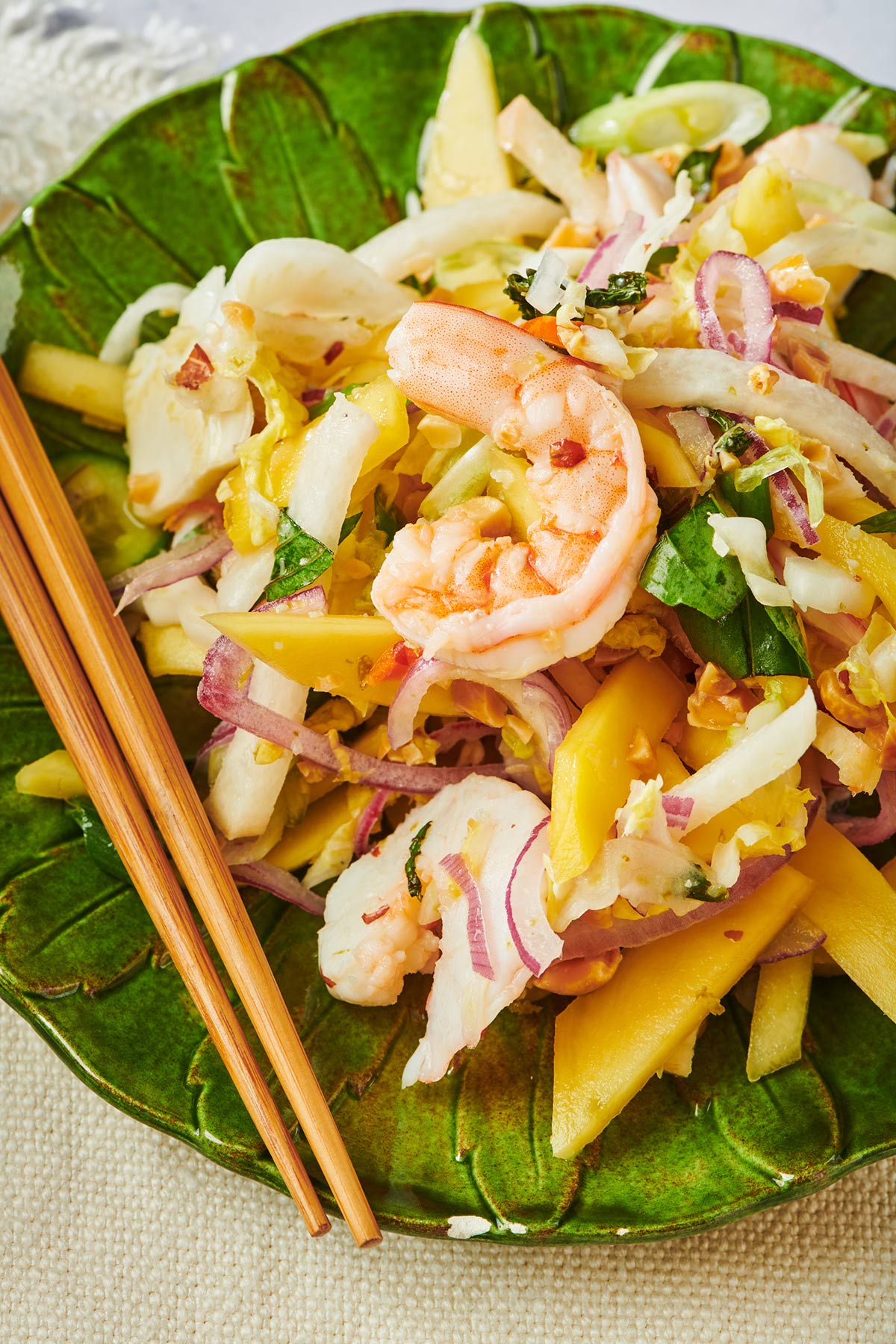
Vietnamese Green Mango Salad with Shrimp (Goi Xoai): Colorful,, bright, and crunchy, this salad is a refreshing meal or a beautiful part of a Southeast Asian spread.
Choosing Mangos for Salad
You definitely want to use green or unripe mangos in the salad. Try to find hard mangos, which are best for this salad. The green part refers more to the skin of the mango, which — when unripe — is green, and turns orange as it ripens. The interior flesh of the mango will still be a pale orange, perhaps with a green tinge here and there. The flavor is mild, a bit sour, and there is a pronounced crunch.
You can find unripe mangos at many supermarkets (it’s nice when an unripe mango is what you want, rather than a frustration!). You can also look for them at specialty stores, Asian markets, and Caribbean grocery stores.
If your mango is a bit more on the ripe side, your salad will have a bit more juiciness and sweetness to it, which is also delicious but not the traditional flavor profile of this salad. Don’t use a fully ripe mango, however, as it will be too soft and too sweet. If you have a hard mango that is starting to soften, put it in the fridge until you are ready to make this salad. The cold will slow down the ripening process.
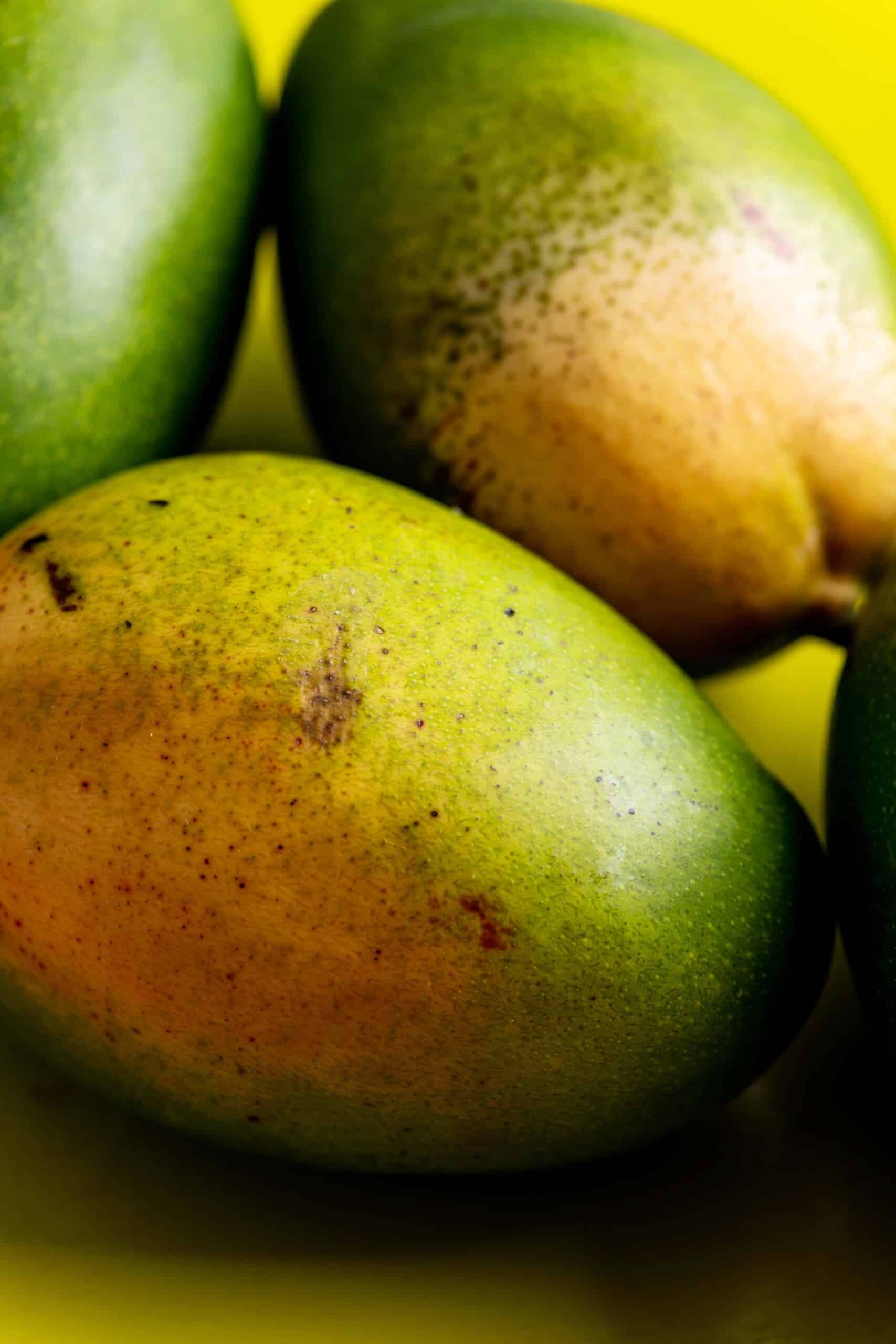
Cutting Mangos for Mango Salad
For this salad, you want to cut the mango into matchsticks, which allows it to mingle with all of the other ingredients, so there is a little burst of the unripe mango flavor in every bite. The fact that the mango is unripe and hard makes this easy to do — it’s pretty much impossible to cut a ripe mango into matchsticks, as the flesh is too soft.
The easiest way to cut a green mango into matchsticks is to first peel the mango with a vegetable peeler. Then, cut the flesh from the pit into large pieces. Slice the pieces into slices about 1/4- to 1/3-inch thick. Then, slice those slabs crosswise into matchstick pieces.
Ingredients for Vietnamese Mango Salad with Shrimp
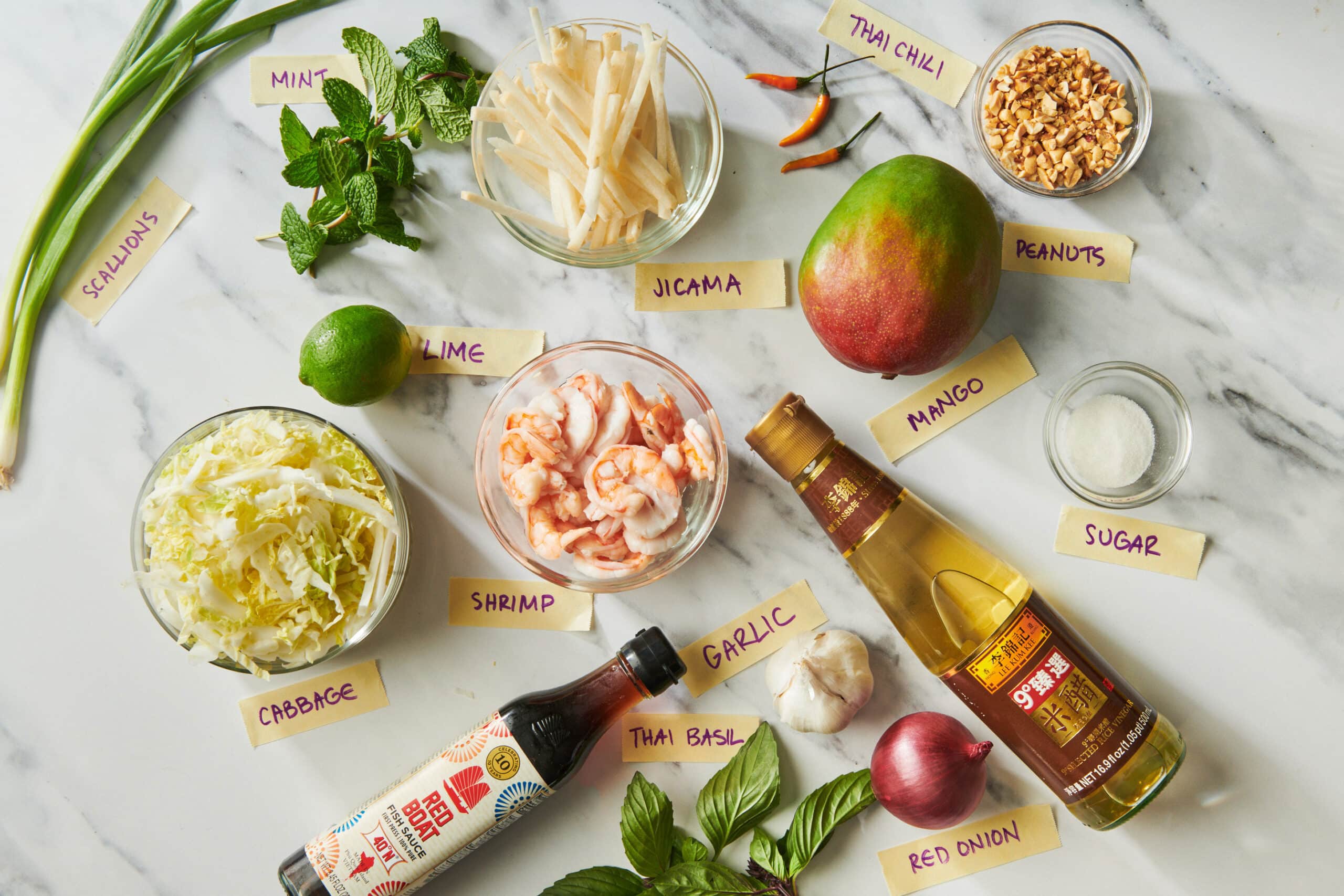
- Cabbage – I like napa cabbage best in this salad, but you can use any cabbage. Slice the cabbage very thinly so it tosses together easily with the other ingredients.
- Jicama – Adds a clean, fresh crunch to the salad. Peel the jicama and cut it into thin matchsticks.
- Green (unripe) mango – The central ingredient of the salad! See above for how to cut a green mango into matchsticks easily.
- Onion – I love red onions in these Southeast Asian salads because I want to add to the visual appeal in every way! Cut the onion in half, and thinly slice it into half moons.
- Scallions – Another member of the onion (allium) family. Use both white and green parts, sliced on the diagonal. Slice up extra scallions for sprinkling over the finished salad.
- Lime – One of the key elements of many Vietnamese dressings, the finely grated zest and juice of one large lime is included here.
- Rice vinegar – For another level of mild acidity. Use unseasoned rice vinegar if possible, but if you have seasoned, it’s okay to substitute for such a small amount.
- Sugar – Just a bit to balance out all of the acidity in the dressing and the tartness of the unripe mango.
- Fish sauce – One of the quintessential flavors of Vietnamese cooking. It provides that salty umami flavor that makes the food so alluring.
- Garlic – Make sure to finely mince the garlic so it blends into the salad seamlessly.
- Chili pepper – Use a thinly sliced Thai or serrano pepper. Traditionally, the seeds are left in, but that’s where most of the heat is held. If you prefer a less spicy salad, you may want to remove some or all of the seeds.
- Herbs – Two of the most commonly used herbs in Vietnamese cooking are included here: Thai (or Asian) basil and mint. Absolutely use fresh, no question about that!
- Cooked shrimp – You can use purchased cooked shrimp or cook them yourself.
- Chopped roasted peanuts – Obviously, skip these if you have any allergy issues. But the nutty, salty crunch from the chopped peanuts is terrific in terms of texture and flavor.
Variations and Substitutions
- Bell pepper and daikon are also good additions, and daikon is a great substitute for the jicama. You can also use a seeded cucumber instead of the jicama.
- Try fresh cilantro in place of one of the herbs, either the basil or the mint.
- If you can find Vietnamese coriander, use that in place or in addition to the other herbs.
- Use unripe papaya instead of the mango.
- Leave out the shrimp if you are serving this as a side to another protein-based main course. You can also try the Vegan Mango Salad recipe.
- If you want a vegetarian dish, leave out the shrimp and use a vegan fish sauce, storebought or homemade.
- Iff you have any leftover Nuoc Mam Chanh from another Vietnamese meal, you can also drizzle some over the salad instead of the dressing.
How to Make Vietnamese Green Mango Salad
- Combine the fruits and veggies: In a large bowl, combine the cabbage, jicama, mango, onions, and scallions.
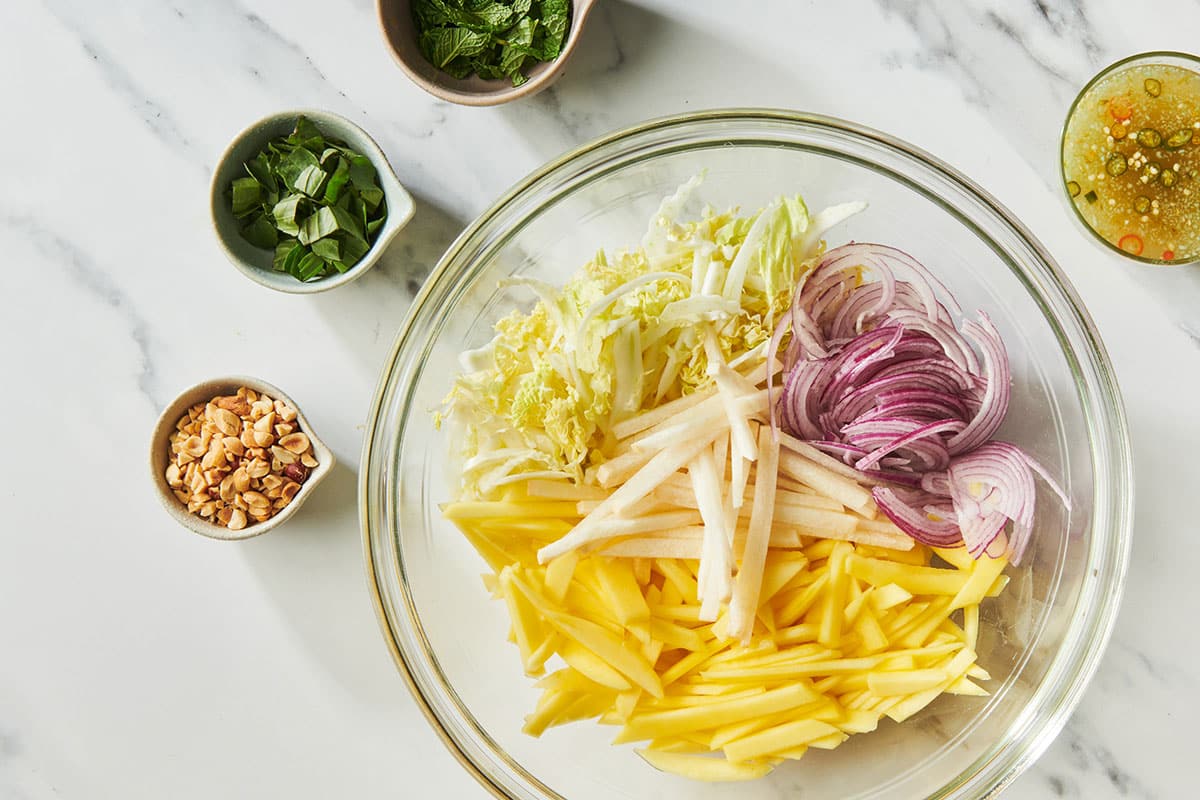
- Make the dressing and toss: In a small bowl, combine the lime zest and juice, rice vinegar, sugar, fish sauce, garlic, and chili. Pour the dressing over the salad and toss.
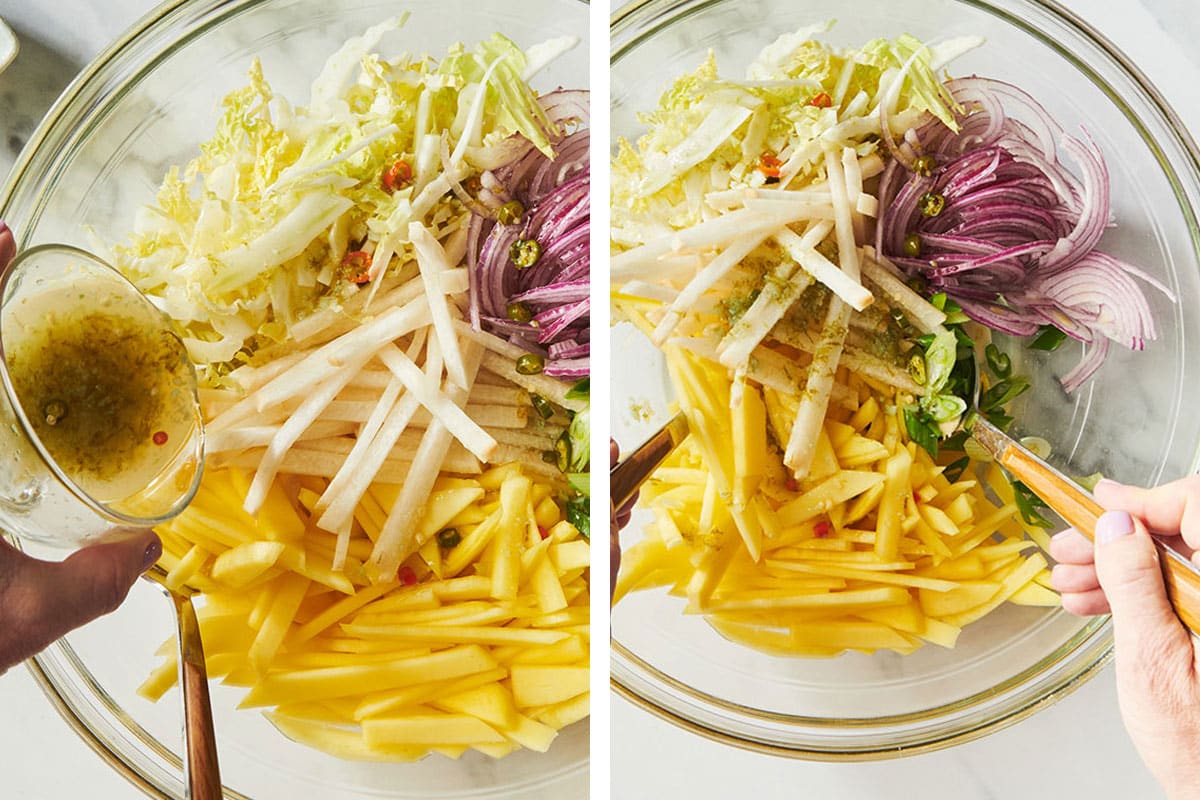
- Add herbs, nuts, and shrimp: Add the mint, basil, and peanuts and toss again until well combined. Add the shrimp and toss.
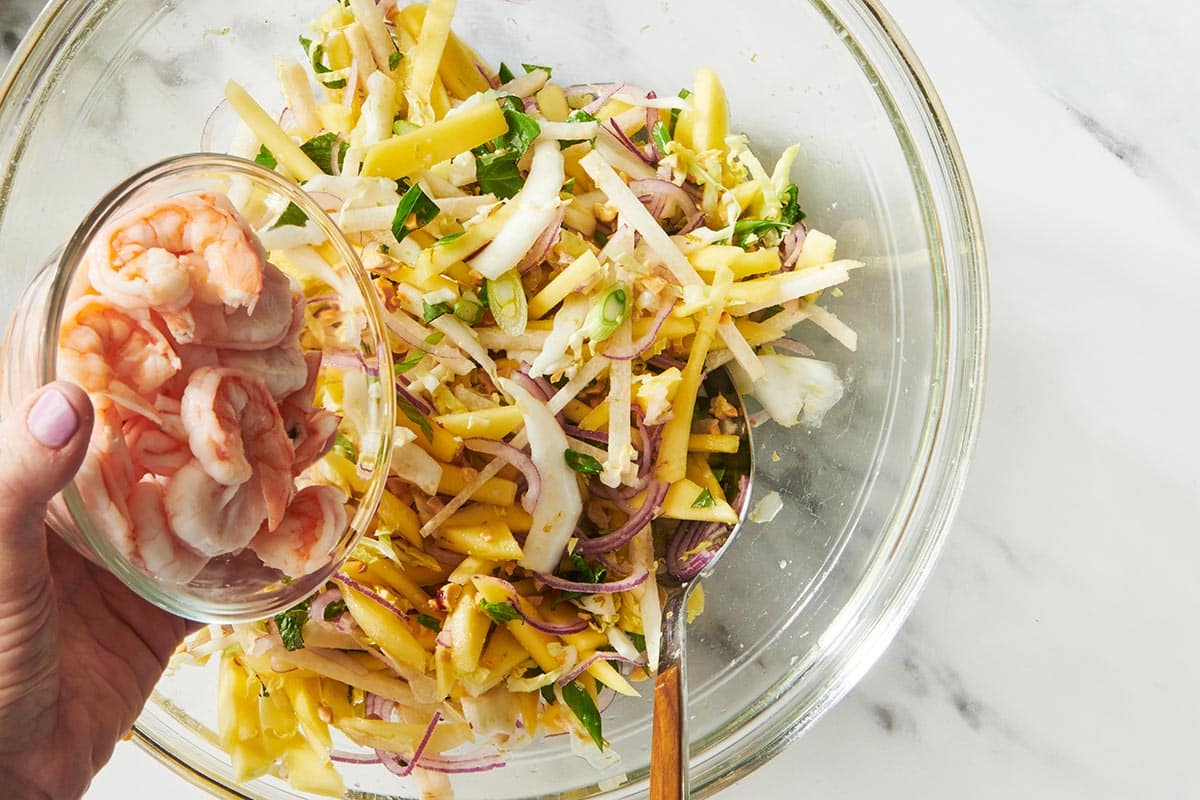
- Serve: Serve immediately, topped with some more sliced scallions and crushed peanuts. Shrimp crackers and or toasted sesame rice crackers or sheets are typical accompaniments to this salad.
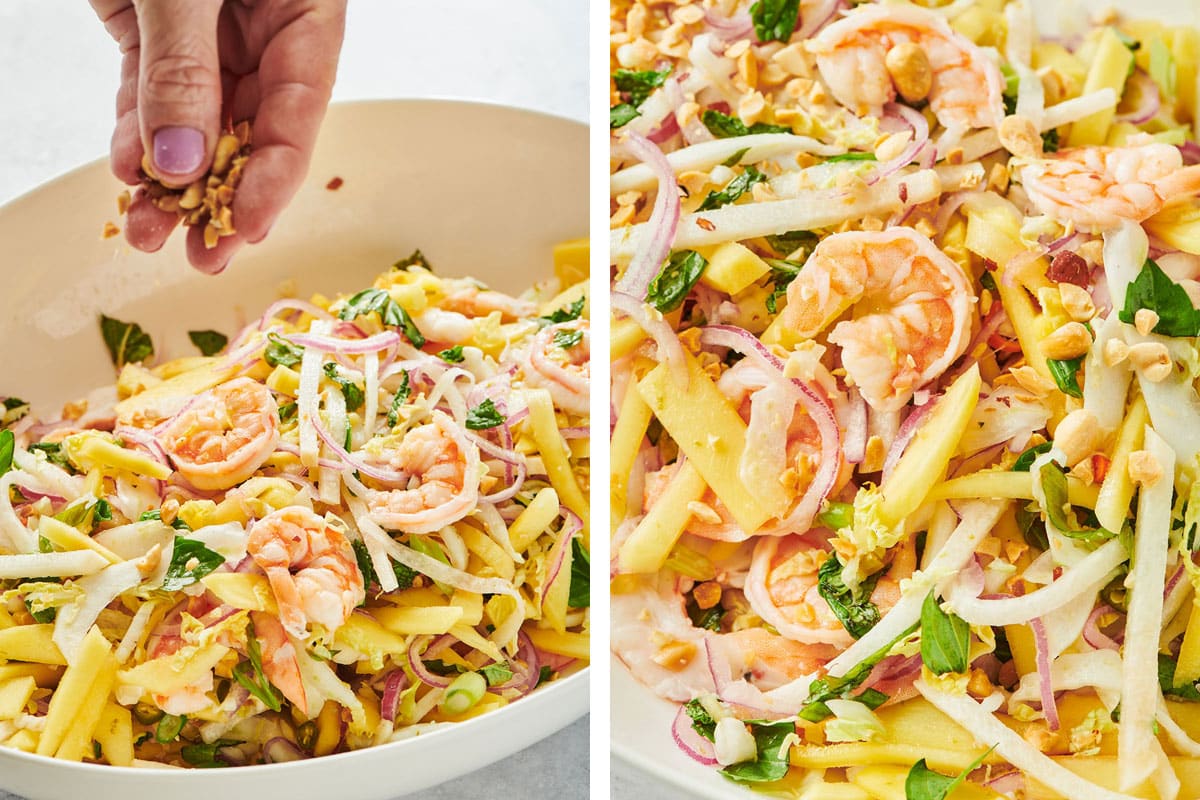
Leftovers and Storage
- Leftovers will keep for 2 days in the refrigerator. The vegetables will soften slightly, but the flavor will still be great!
- If you want to make this ahead, keep the vegetables, shrimp, and peanuts separate. Dress shortly before serving.
FAQs
Yes, a green mango is just a mango that is still quite hard, not a different species of mango. The flavor is refreshing but much less sweet than a ripened mango, and the flesh will be crunchy.
Unripe mango is perfectly safe to eat and is enjoyed throughout Southeast Asia in places like Indonesia, India, Thailand, Vietnam, and the Phillippines. It’s usually used in salads or other cold savory preparations.
What to Serve With Vietnamese Green Mango and Shrimp Salad
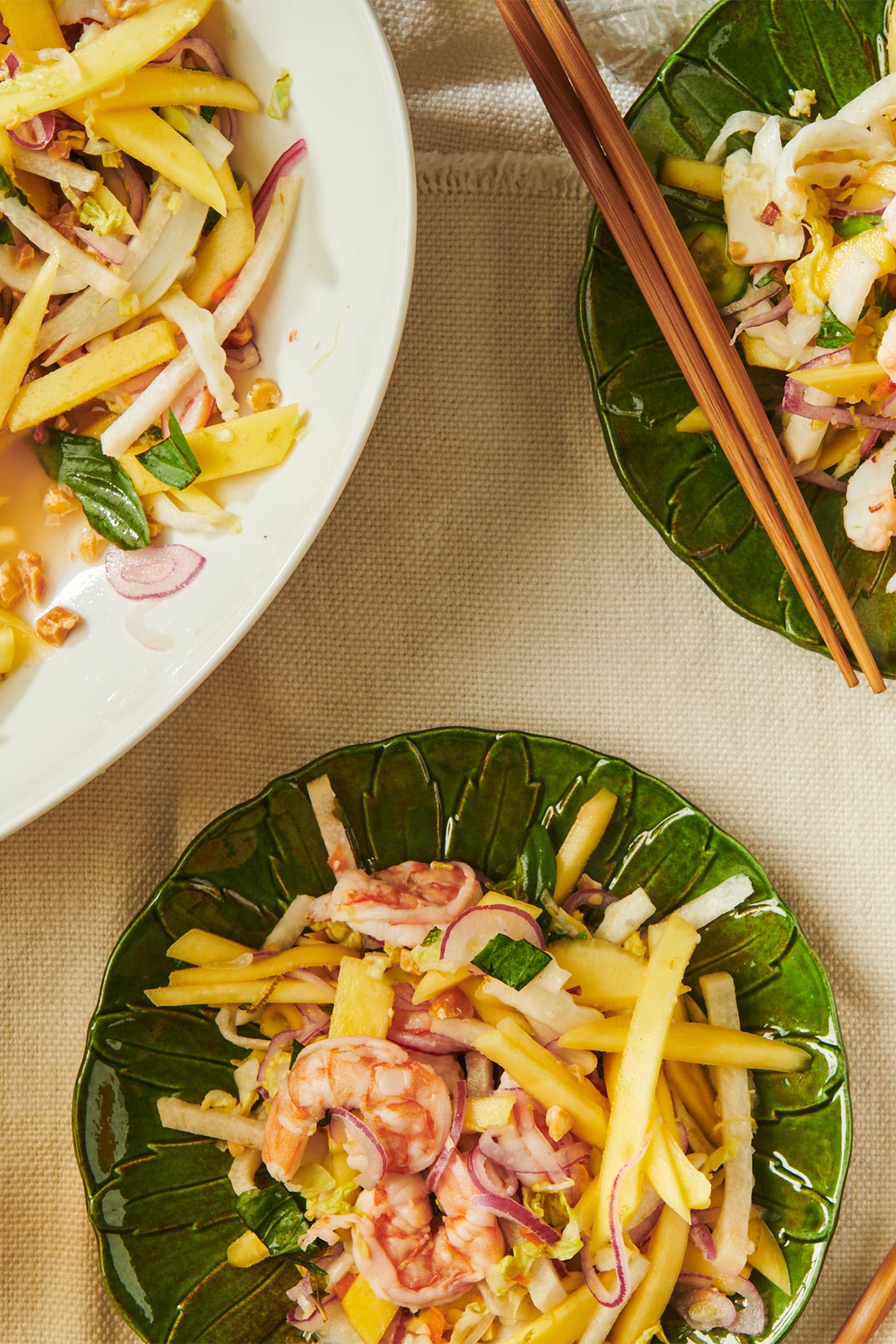
More Asian-Inspired Salads
- Japanese Cucumber Salad
- Vegan Asian Napa Cabbage Slaw
- Asian Kohlrabi and Apple Slaw
- Chicken Satay Salad
Pin this now to find it later
Pin It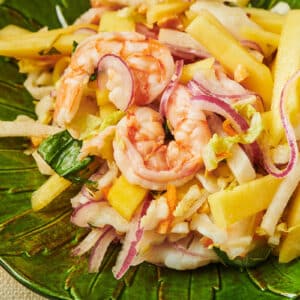
Vietnamese Green Mango Salad with Shrimp (Goi Xoai)
Ingredients
- 2 cups packed thinly sliced napa cabbage
- 1 cup jicama (cut into thin matchsticks; about 1/3 of a large jicama)
- 1 green (unripe) mango (1 pound; peeled and cut into thick matchsticks)
- 1 red onion (halved and thinly sliced)
- 3 scallions (white and green parts sliced on the diagonal; plus more for serving)
- Finely grated zest and juice of 1 large lime
- 2 tablespoons unseasoned rice vinegar
- 2 tablespoons sugar
- 2 tablespoons fish sauce (or vegan fish sauce)
- 1 teaspoon finely minced garlic
- 1 Thai or serrano chili (thinly sliced; see Note)
- 2 tablespoons roughly chopped mint
- 2 tablespoons roughly chopped Thai basil
- ¼ cup chopped roasted peanuts, plus more for sprinkling
- 1 pound cooked, peeled extra-large shrimp
Instructions
- In a large bowl, combine the cabbage, jicama, mango, onions, and scallions.
- In a small bowl, combine the lime zest and juice, rice vinegar, sugar, fish sauce, garlic, and chili pepper.
- Pour the dressing over the salad and toss. Add the mint, basil, and peanuts and toss again until well combined. Add the shrimp and toss. Serve immediately, topped with some more sliced scallions and crushed peanuts.
Notes
- Try adding thinly sliced bell pepper and daikon.
- Daikon is a great substitute for the jicama.
- Try using a seeded cucumber instead of the jicama.
- Substitute fresh cilantro in place of one of the herbs, either the basil or the mint.
- Look for Vietnamese coriander, which you can use as an alternate, or in addition to the other herbs.
- Replace the unripe mango with unripe papaya.
